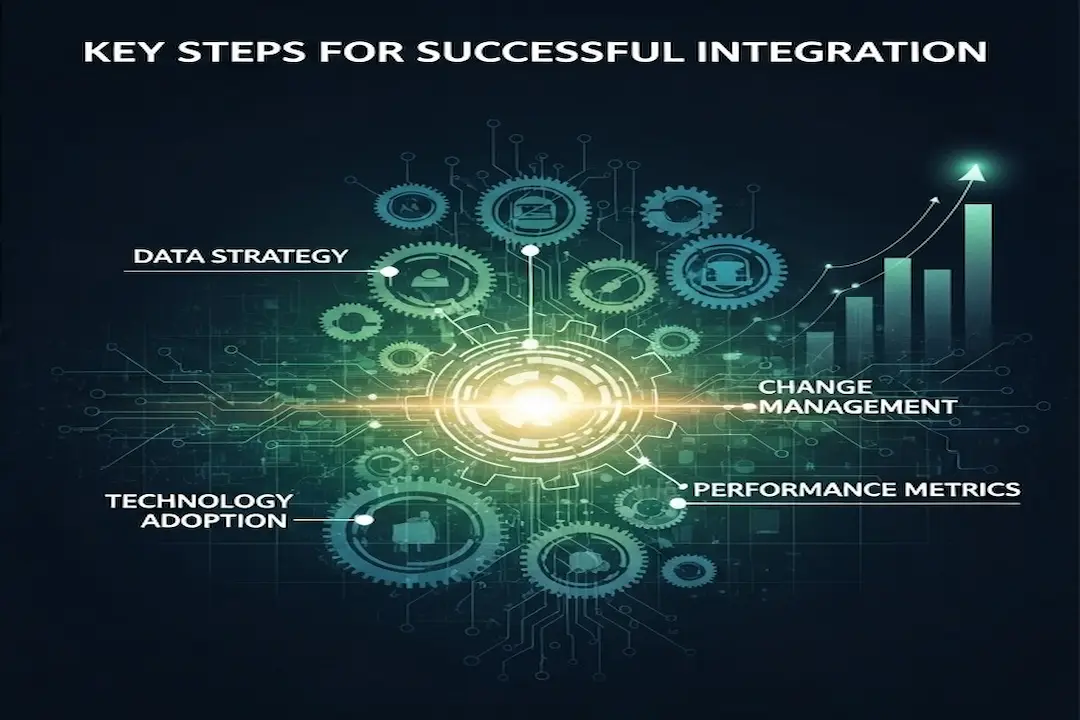
As today’s digital environment accelerates, Artificial Intelligence (AI) stands out as more than just industry jargon—it’s the powerhouse driving innovation, efficiency, and a distinct edge for businesses everywhere. Whether through automating routine functions or fueling predictive analytics that transform executive choices, AI’s transformative impact is clear. For tech-savvy small business leaders, modern marketing experts, and keen enterprise IT professionals, the question isn’t if AI will reshape operations, but when and how well you’ll deploy it.
Yet, acquiring AI solutions alone won’t guarantee results. The crucial factor is an organization’s AI readiness—a thorough evaluation of your existing competencies, systems, and workplace culture to pave the way for seamless and successful AI deployment. Skipping this vital groundwork can render even the most sophisticated AI investments fruitless, resulting in squandered budgets and lost opportunities.
This guide explores the pivotal steps to assessing AI readiness, equipping you to embark on your AI journey with confidence, strategy, and measurable achievement.
Table of Contents
Understanding AI as a Strategic Asset
AI isn’t simply a technical upgrade; it’s a game-changing asset capable of reshaping your business blueprint, customer relations, and operational strength. Think of AI as a strategic ally—one that opens doors to fresh growth and organizational resilience.
Benefits of AI Adoption
Adopting AI is about more than matching rivals—it’s about forging ahead. Its positive effects ripple companywide, boosting everything from productivity to satisfaction.
- Improved Productivity: Automation with AI streamlines tedious, repetitive work so your team can devote time to innovation and problem-solving. Envision AI chatbots fielding routine customer inquiries, enabling your staff to tackle complex challenges and nurture client relationships. This division leads to lower costs and greater efficiency.
- Enhanced Decision-Making Capabilities: AI excels at swiftly analyzing massive datasets, supplying businesses with deep insights into markets, customer habits, and pain points. Leadership gains sharper, proactive decision-making power, reducing risks and maximizing advantages.
- Increased Customer Satisfaction: AI delivers uniquely tailored customer experiences at scale. From personalized recommendations to instant, round-the-clock support, intelligent bots foster loyalty by making every customer feel seen and appreciated.
Example/Statistic Needed: Major consultancies like Accenture and Deloitte continually report that AI strategies sharply boost productivity. One noted study found that early AI adopters enjoyed a 20–30% rise in productivity across core operations, revolutionizing everything from analytics to content creation. Such leaps represent transformational—not gradual—improvements in business potential.
Steps for Assessing AI Readiness
Thoroughly evaluating AI readiness spans technical, data, and human dimensions. It demands a big-picture approach that goes far deeper than technology alone, examining the organization as a whole.
Evaluating Technical Infrastructure
Every effective AI rollout rests on a resilient, scalable technology foundation. Without it, even the best-intentioned AI initiatives may falter.
- Importance of Cloud Computing Capabilities: Cloud solutions deliver the compute power, storage, and specialized AI tools needed to build, launch, and manage AI models. This negates large upfront hardware spending, opening doors for businesses of all sizes to compete. With cloud-native setups, teams can iterate and grow AI initiatives quickly.
- Data Storage Solutions: Data is fuel for AI. Secure and flexible storage—like data lakes for unprocessed content and data warehouses for organized info—is essential. Seamless data ingestion, handling, and retrieval are prerequisites for reliable AI results.
- Recommended Platforms: AWS, Google Cloud, Microsoft Azure: These leading cloud services house robust AI offerings, with prebuilt APIs and advanced machine learning suites. Each platform has unique strengths, suiting a variety of tech stacks and business needs.
Example Needed: Picture a scaling e-commerce company. Managing inventory and delivering personalized service manually quickly became unsustainable. By moving operations to AWS and utilizing Amazon SageMaker for demand forecasts and Amazon Personalize for customer curation, they reinvented processes. This transition curbed stockouts by 15% and deepened engagement, demonstrating the real-world payoff of investing in cloud infrastructure for AI.
Assessing Data Quality
AI’s effectiveness is only as strong as its data. The reliability and accuracy of AI systems are directly tied to the standard of the information they learn from. “Garbage in, garbage out” holds truer than ever in AI.
- Define Structured vs. Unstructured Data:
- Structured Data: Well-organized, easily stored in rows and columns—for example, CRM profiles or sales spreadsheets. Simple for AI to digest and analyze.
- Unstructured Data: Lacks a preset arrangement—spanning emails, images, social media, audio, or reviews. While plentiful, it demands intricate AI capabilities (think NLP, image recognition) for insights.
- Identifying and Resolving Data Silos: Disconnected systems and departments hoarding separate data sets block a comprehensive, unified view. These silos undermine AI, leading to biased outputs and incomplete models. Overcoming them with robust integration is critical.
Statistic Needed: An astounding 70% of organizations cite poor data quality as a top barrier in AI projects, causing erroneous predictions, sluggish progress, and missed targets. Such figures stress the need for disciplined data stewardship before embracing AI head-on.
Here’s a table of common data quality barriers and their AI impact:
| Data Quality Issue | Description | Impact on AI Initiatives |
|---|---|---|
| Incompleteness | Missing values or records in datasets. | Leads to biased models and inaccurate predictions. |
| Inconsistency | Conflicting data across different sources. | Causes confusion, errors, and unreliable AI outcomes. |
| Inaccuracy | Incorrect or erroneous data points. | Results in flawed insights and potentially harmful decisions. |
| Irrelevance | Data that doesn’t pertain to the AI problem being solved. | Wastes processing power and dilutes model effectiveness. |
| Lack of Timeliness | Outdated data used for current predictions. | Models fail to capture real-time trends, leading to poor performance. |
Evaluating Organizational Culture
True AI integration hinges on people as well as technology. Your organization’s culture—its mindset and adaptability—can make or break an AI initiative.
- Importance of a Cultural Shift Towards Innovation: The foundations of AI readiness are openness to change, continuous learning, and a drive to experiment. Encouraging an innovative spirit and replacing fear of failure with curiosity unlocks AI’s possibilities.
- Encouraging Experimentation: Progress in AI comes from piloting, iterating, and learning from both hits and misses. A culture of psychological safety—where staff can innovate without fear of blame—is indispensable.
Case Study Needed: Take Netflix—not merely a story of embracing AI, but a blueprint for cultural experimentation. Their transition from mailing DVDs to a platform fueled by AI recommendations showcases relentless innovation. Their persistent investment in cloud and A/B testing planted the seeds for an agile, data-driven culture, letting AI become core to ongoing success and reinvention.
Leadership Support for AI Initiatives
Transformation begins at the top. Executive endorsement isn’t just helpful—it’s essential to enduring change, especially in a shift as significant as AI.
- The Role of Executive Buy-in in Successful AI Integration: Forward-thinking leadership doesn’t just approve budgets—they spearhead the AI vision, allocate resources, and unify the company behind the AI agenda. Without strong champions, AI projects stagnate or dissolve amid competing interests.
- Identifying Leaders Who Understand AI’s Transformative Potential: Ideal leaders needn’t be technologists, but must grasp AI’s business applications and unite technical and operational teams under a common purpose, driving adoption and breakthrough results.
Implications of AI Readiness
AI readiness isn’t just a checklist for deployment—it’s a long-term strategic investment with organizational ripple effects well into the future.
Long-Term Organizational Benefits
A robust approach to AI readiness sets the stage for enduring growth and adaptation.
- Positioning for Future Innovations in AI: Building the right base in people, data, and systems readies you to capitalize on tomorrow’s AI advances, ensuring your position at the forefront of your field.
- Continuous Adaptation in a Competitive Landscape: Markets shift rapidly. A well-integrated AI practice empowers businesses to predict trends, cater to emerging needs, and swiftly recalibrate—fueling sustained competitiveness.
The Necessity of Ongoing Education and Training
AI is in constant evolution; your workforce must grow with it.
- Importance of Upskilling Employees: As AI assumes certain functions, human roles must evolve—learning to manage, interpret, and collaborate with AI. The goal isn’t man vs. machine, but the elevation of each employee’s potential.
- Creating an AI Literacy Program: Launch multi-level education initiatives teaching AI basics, practical applications, and ethical considerations. Unified understanding eases uncertainty, reduces fear, and galvanizes collective involvement in AI progress.
Conclusion
Achieving successful business AI integration is a layered process—requiring technical review, superior data governance, cultural openness, and unwavering leadership. It’s less a sprint and more a long-term strategy, demanding planning, resourcefulness, and adaptability. Conducting a thorough AI readiness evaluation arms your organization to not just install AI, but excel with it—turning obstacles into stepping-stones and securing a lasting competitive advantage.
This assessment illuminates your current landscape, sheds light on strengths, and pinpoints improvement areas. Welcome this strategic stance on AI, and you’ll realize the future isn’t happening to you—you’re designing it.
Ready to build a future-proof AI strategy for your business? Webologists helps companies assess readiness, align leadership, and integrate AI solutions that drive measurable growth. Let’s design a custom roadmap to transform your operations with AI—built for real results.
FAQs
-
What is an AI strategy for businesses?
An AI strategy is a structured plan that helps companies integrate artificial intelligence into their operations to improve efficiency, automate processes, and make data-driven decisions.
-
Why is AI strategy important for modern businesses?
A clear AI strategy ensures technology investments align with business goals, driving innovation, better customer experiences, and long-term competitive advantage.
-
What are the main steps in creating an AI strategy?
Start by assessing readiness, defining use cases, preparing data, building technical infrastructure, and training teams. Leadership alignment and pilot testing are also essential.
-
How can small and mid-sized businesses adopt an AI strategy?
They can begin with cost-effective cloud AI tools, automate one key process, and scale gradually. Many platforms like AWS, Google Cloud, and Azure offer prebuilt AI services.




